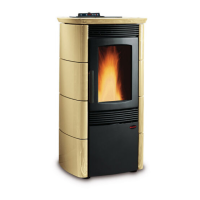12
The pellets are made by applying very high
pressure to sawdust, that is pure timber waste
(without paint), produced by sawmills, carpentry
works and other activities associated with the
working and transformation of timber.
This type of fuel is completely environmentally
friendly as no binders of any kind are used to
keep it compact. In fact, the compactness of the
pellets over time is guaranteed by a natural
substance found in the wood itself: the lignite.
As well as being environmentally friendly, as the
wood residues are exploited to the maximum,
pellets also have technical advantages.
While wood has a calorific power of 4.4
kW/kg. (with 15% humidity, after about 18
months seasoning) the power of pellets is 5.3
kW/kg. The density of the pellet is 650 Kg/m3
and the water content is 8% of its weight.
For this reason, the pellets do not need to be
seasoned to obtain an adequate caloric yield.
Their diameter ranges from a minimum of 5
mm to a maximum of 8 mm.
4.1 Pellet storage
To guarantee problem-free combustion, the
pellet must be stored in a dry place.
WARNING
THE USE OF POOR QUALITY PELLETS OR OF
ANY OTHER MATERIAL DAMAGES THE
FUNCTIONS OF YOUR STOVE AND MAY
LEAD TO THE INVALIDATION OF THE WAR-
RANTY
AND ASSOCIATED RESPONSIBILITIES
OF THE MANUFACTURER.
4 WHAT ARE PELLETS ?

